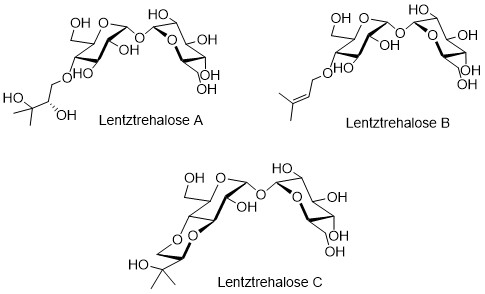Lentztrehalose on:
[Wikipedia]
[Google]
[Amazon]
 Lentztrehaloses A, B, and C are
Lentztrehaloses A, B, and C are
 Lentztrehaloses A, B, and C are
Lentztrehaloses A, B, and C are trehalose
Trehalose (from Turkish '' tıgala'' – a sugar derived from insect cocoons + -ose) is a sugar consisting of two molecules of glucose. It is also known as mycose or tremalose. Some bacteria, fungi, plants and invertebrate animals synthesize it ...
analogues found in an actinomycete ''Lentzea
''Lentzea'' is a Gram-positive, mesophilic and aerobic genus from the family Pseudonocardiaceae
The Pseudonocardiaceae are a family of bacteria in the order Actinomycetales and the only member of the suborder Pseudonocardineae.
Genomics
Th ...
'' sp. ML457-mF8. Lentztrehaloses A and B can be synthesized chemically. The non-reducing disaccharide trehalose is commonly used in foods and various products as stabilizer and humectant, respectively. Trehalose has been shown to have curative effects for treating various diseases in animal models including neurodegenerative diseases, hepatic diseases, and arteriosclerosis. Trehalose, however, is readily digested by hydrolytic enzyme trehalase
The enzyme Trehalase is a glycoside hydrolase, produced by cells in the brush border of the small intestine, which catalyzes the conversion of trehalose to glucose. It is found in most animals.
The non-reducing disaccharide trehalose (α-D-glucop ...
that is widely expressed in many organisms from microbes to human. As a result, trehalose may cause decomposition of the containing products. And its medicinal effect may be reduced by the hydrolysis by trehalase. Lentztrehaloses are rarely hydrolyzed by microbial and mammalian trehalases and may be used in various areas as a biologically stable substitute of trehalose.
References
{{Reflist, 30em Disaccharides Carbohydrates